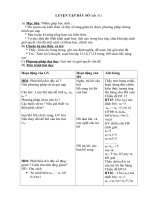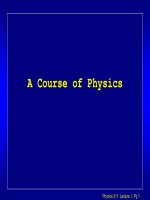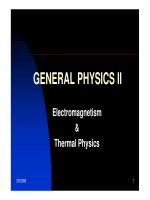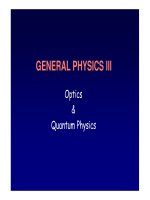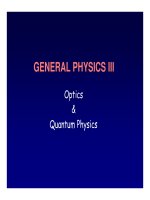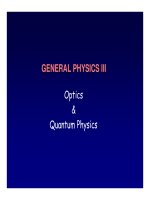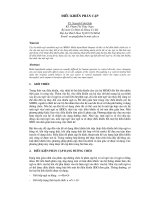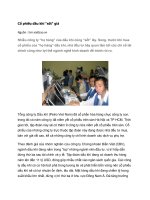- Trang chủ >>
- Khoa Học Tự Nhiên >>
- Vật lý
Tài liệu Chapter XXV Quantum Generators pptx
Bạn đang xem bản rút gọn của tài liệu. Xem và tải ngay bản đầy đủ của tài liệu tại đây (388.28 KB, 17 trang )
GENERAL PHYSICS III
GENERAL PHYSICS III
Optics
&
Quantum Physics
Chapter XXV
Chapter XXV
Quantum Generators
Quantum Generators
§1. Principle of light amplification
§2. Properties of laser beams
Light
Amplification by
Stimulated
Emission of
Radiation
Quantum generators are
light sources that work by
a special principle of light
amplification
§1.Principle of light amplification:
1.1 Radiative processes:
1.1.1 Absorption:
• Atoms absorb light (photon) and transist
from a lower to higher (exited) energy levels
• Absorption rate:
112
112
1
FN
NW
dt
dN
abs
E
1
E
2
• Note: Typical value of
N1 ~ 10
20
/cm
3
12
~ 10
-19
÷ 10
-18
cm
2
1.1.2 Spontaneous emission:
• The emission of light that takes place
completely randomly.
• When, and in which direction, the light
will be emitted? It cannot be
determined before it actually happens.
• We cannot manage this emission.
sp
sp
N
AN
dt
dN
/
2
2
2
E
2
E
1
The process is spontaneous by nature. This gives the effect its
name: spontaneous emission.
1.1.3 Stimulated emission:
E
1
E
2
• Imagine an atom with excess energy. Without external action,
the atom would, after a period of time, spontaneously emit light,
whose properties (e.g. its direction) are random — only the
energy is fixed.
• This situation changes when the
atom is shone with a light wave of
the corresponding energy. There
is then a higher probability that
the atom will also simply copy the
remaining properties of the incident
wave: It then emits light that is
in step with the original and
propagates in the same direction.
• In contrast to spontaneous emission, this effect is known as stimulated
emission. This is the effect that causes the light in the laser to be
amplified, and also gives the process its name:
Light Amplification by
Stimulated Emission of Radiation
.
